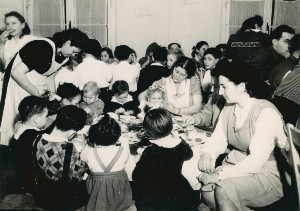Witnessing the Recovery: Storytelling and Family Building, from Belsen to Ireland
Professor Mary Kirsh presented her lecture “Witnessing the Recovery: Storytelling and Family Building, from Belsen to Ireland.” An article of the same name is forthcoming. For this lecture Professor Kirsh focused on a nurse, an administrator, and a pediatrician, all of whom acted in caregiving roles to victims of the Bergen-Belsen concentration camp. All three narrated the recovery process in a variety of texts, from letters to published novels. Holocaust narratives typically focus on victims and survivors, but Professor Kirsh drew attention to the unique position of caregivers as storytellers due to their function in the rehabilitation process. She quoted scholar James Young’s understanding of caretakers—that they “represent the sense of discontinuity and disorientation in catastrophic events.” While previous scholarship has looked to administrative records to ascertain what the recovery process looked like for victims and caregivers, the cases Professor Kirsh spoke about show the importance of emotions in the rehabilitation process and how those involved often took initiative beyond policy measures. Their writing is not only a record but a means by which to process the trauma of the war. Writing allowed them to grapple with how to give aid to others while also caring for themselves.

Professor Kirsh first told the story of Muriel Knox Doherty (1896-1988), who had built a career as nurse and eventually joined the United Nations Rehabilitation Administration. Upon her arrival at Bergen, she was instrumental in the transition of the premises there from an emergency hospital to a rehabilitation facility (despite staffing issues and inadequate resources). She built a children’s ward, believing that helping children find permanent homes and rebuilding families was crucial to the well-being of the survivors. Although she knew she could never fully comprehend the suffering her patients had lived through, she felt compelled to act as a witness and communicate to her friends and family in letters that “[i]t concerns us all.”
Professor Kirsh concluded the lecture by looking at the work of Olga Eppel, an Irishwoman born in 1898 to religiously observant Jews. Unlike Collis, who left behind substantial autobiographic writings, Eppel’s life is under-documented. What we do have are her professional letters which do nothing to romanticize the rehabilitation process, but rather reveal logistical needs. After the war, Eppel was placed at Clonyn Castle in Delvin to assist with Operation Shamrock, a three-year initiative to offer refuge to displaced children. Until this point, the Irish government had staunchly opposed attempts to take refugees from the war. Practical concerns about heating, low staffing, and general disorganization distracted Eppel from the rehabilitation process, but another issue was the reception of the migrant children in the existing community. In Eppel’s letters, we see that while some Catholics welcomed the refugees, antisemitism was a pervasive force in the local community and wider country. Eppel was concerned about the impression the children made on the local families, and communicated her hope that they might act as model refugee children and serve as ambassadors for Judaism. Still, she deeply wanted their time at Clonyn Castle to be one of healing, and some of the children would later recall the warmth of the staff.
Doherty, Collis, and Eppel are just a handful of caretakers who participated in rehabilitation and storytelling. Professor Kirsh is also currently at work on the manuscript for her book Writing the Recovery: Stories of Rehabilitation in the Post-Holocaust Era, which examines caregiving and storytelling in different regions in the post-Holocaust years. Although these stories come out of liminal spaces, they speak to the overall power of storytelling and the significance of the emotions of children and caregivers alike in the process of rehabilitation.















